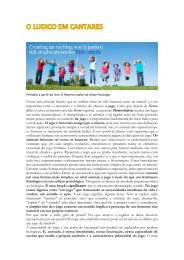Motherhood in Childhood
You also want an ePaper? Increase the reach of your titles
YUMPU automatically turns print PDFs into web optimized ePapers that Google loves.
s Youth peer<br />
educators of<br />
Geração Biz<br />
<strong>in</strong> Maputo,<br />
Mozambique.<br />
© UNFPA/Pedro<br />
Sá da Bandeira<br />
Additionally, the proportion of marriages of girls<br />
before age 18 fell to 61.8 per cent compared to<br />
80.7 per cent for girls outside the programme<br />
(Pande et al., 2006).<br />
Attitudes of boys and men have a significant<br />
impact on the health, rights, social status and<br />
well-be<strong>in</strong>g of girls and thus on girls’ vulnerability<br />
to pregnancy. In many countries, UNFPA<br />
supports programmes to work with boys, male<br />
adolescents and youth on sexuality, family life<br />
and life-skills education to question current<br />
stereotypes about mascul<strong>in</strong>ity, male risk-tak<strong>in</strong>g<br />
behaviour (especially sexual behaviour) and to<br />
promote their understand<strong>in</strong>g of and support<br />
for women’s rights and gender equality. In some<br />
countries, UNFPA has partnered with national<br />
<strong>in</strong>stitutions to raise awareness of the impact of<br />
negative attitudes and harmful practices on<br />
girls and women through school-based, ageappropriate,<br />
comprehensive sexuality education<br />
or with civil society organizations to engage<br />
men and boys <strong>in</strong> dialogue about their attitudes<br />
towards issues such as child marriage, contraception<br />
and matters of sexual and reproductive<br />
health and reproductive rights.<br />
Invest<strong>in</strong>g <strong>in</strong> services for<br />
adolescents and young people<br />
Adolescents—married or unmarried—often lack<br />
access to contraceptives and <strong>in</strong>formation about<br />
their use. Barriers <strong>in</strong>clude a lack of knowledge of<br />
where to obta<strong>in</strong> them, fear about be<strong>in</strong>g rejected<br />
by service providers, opposition by a male partner,<br />
community stigma about contraception or<br />
adolescent sexuality, <strong>in</strong>convenient locations or<br />
cl<strong>in</strong>ic hours, costs, and concerns about privacy<br />
and confidentiality.<br />
To make it easier for adolescents to learn<br />
about prevent<strong>in</strong>g pregnancy and sexually transmitted<br />
<strong>in</strong>fections, <strong>in</strong>clud<strong>in</strong>g HIV, or to obta<strong>in</strong><br />
contraceptives, an <strong>in</strong>creas<strong>in</strong>g number of countries<br />
have established youth-friendly sexual and<br />
reproductive health services. Youth-friendly services<br />
typically ensure adolescents’ privacy, are <strong>in</strong><br />
locations—and are open at hours—that are convenient<br />
to young people, are staffed by providers<br />
who are tra<strong>in</strong>ed <strong>in</strong> meet<strong>in</strong>g young people’s needs,<br />
and offer a complete package of essential services.<br />
Nicaragua, for example, is <strong>in</strong>creas<strong>in</strong>g disadvantaged<br />
adolescents’ and young people’s access to<br />
sexual and reproductive health services, <strong>in</strong>clud<strong>in</strong>g<br />
70 CHAPTER 4: TAKING ACTION

















